Sketchbook fans are loving trends like minimalist line art, with its smooth lines and clean look, and maximalist collage, where magazine scraps and textures go wild together. Pressed flowers and cool sticker layers bring in a splash of nature and personality, while monochrome magic lets one color totally take over. Hand-lettered quotes and dreamy watercolor make things feel artsy and personal. Even simple doodles and bold color blocks have their moment—plus, there’s way more coming up if you keep going.
Key Takeaways
- Explore minimalist line art using single, clean strokes to achieve a modern, striking look with plenty of intentional empty space.
- Layer magazine cutouts, fabrics, and stickers for maximalist collage pages overflowing with color, texture, and visual storytelling.
- Press real flowers and leaves into your sketchbook for organic, botanical-themed spreads that blend art with nature’s textures.
- Hand-letter expressive quotes using varied lettering styles and media to add personal flair and visual interest to your pages.
- Use vibrant color blocking or monochrome palettes to make striking, cohesive spreads with bold impact and simplified artistic decisions.
Minimalist Line Art
Even though it might look super simple at first, minimalist line art can seriously grab your attention. This style loves clean, crisp lines—sometimes just one smooth swoop makes an entire picture!
Minimalist line art is all about cutting out what you don’t need so the essentials totally stand out. Want a cool face or animal in your sketchbook? Just a few careful lines, maybe a dash of color, and boom, you’ve got something eye-catching.
Artists use a lot of empty space, too, so every part of the page feels intentional, not boring. For anyone hunting sketchbook ideas, minimalist line art is an awesome pick. It’s easy to start, looks modern, and you never have to worry about “messing up” tons of details.
Maximalist Collage Layers
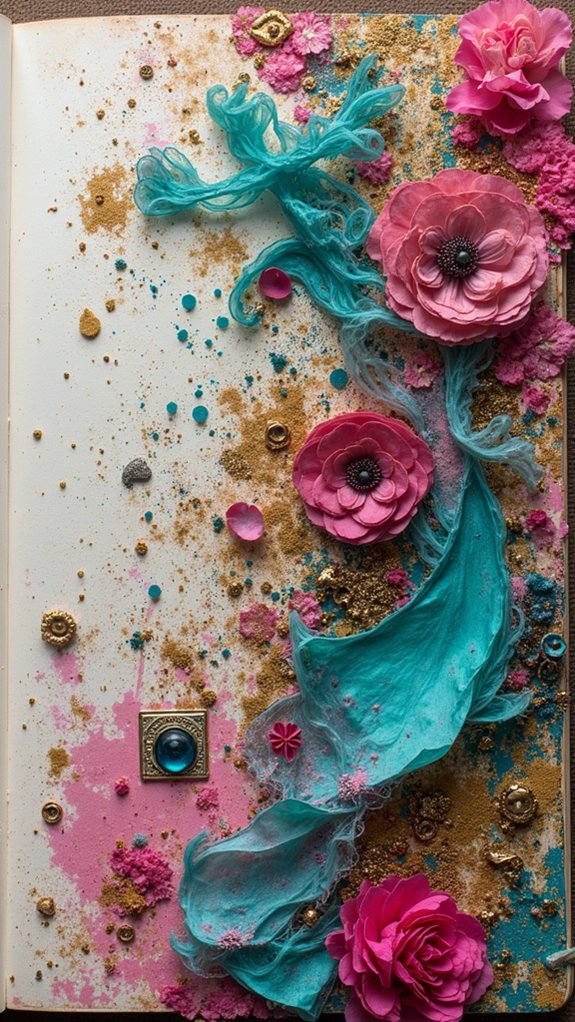
Maximalist collage layers in sketchbooks crank up the drama by mixing textures and media, like slapping down magazine cutouts next to ripped fabric or a splash of bold paint.
Overlapping imagery is the secret weapon here, letting a photo of a cat peek out from behind a shiny candy wrapper so the page feels alive and bursting with surprises.
It’s organized chaos, and honestly, it turns every sketchbook spread into a wild adventure for your eyes and your fingers.
Mixing Textures and Media
When artists start layering different textures and materials—like bits of fabric, paint, paper cutouts, and, yes, maybe that weird shiny candy wrapper they found on the floor—suddenly, their sketchbook pages explode with energy.
Mixing textures and media is all about letting creativity drive the bus (even if it’s a funky, patchwork bus made of magazine clippings and doodles). A page that combines soft cloth, ripped-up old homework, and a splash of acrylic paint instantly feels richer. Touch it, and it’s alive. The contrast between smooth, rough, shiny, and matte keeps the viewer hooked.
- Combining fabric, paper, and paint adds visual excitement.
- Mixing textures and media lets artists tell deeper, more personal stories.
- Limiting colors or repeating shapes helps things look put together, not just chaotic.
Overlapping Imagery Techniques
Although it might look wild at first glance, overlapping imagery in sketchbooks is where things really start to pop off.
With overlapping imagery techniques, artists can layer tons of stuff—think splashes of paint, scraps of patterned paper, or even pieces of fabric—right on top of each other. The result isn’t just a jumbled mess; it’s a super cool maximalist collage where every layer adds something new to the story.
Throw in a bit of transparent tape or vellum, and suddenly there’s a whole secret world peeking through underneath!
Playing with different sizes and directions totally breaks the rules in the best way. Overlapping imagery techniques are all about letting creative chaos rule and building up artwork that no one can stop looking at.
Hand-Lettered Quotes
Hand-lettered quotes are like little pops of personality bursting from the pages of a sketchbook. They combine art and typography, so each quote brings flair and energy—sometimes even a splash of attitude!
Choosing different lettering styles, like bold brush lettering or classic serif fonts, gives these quotes their own unique vibe. Plus, the choice of tools—markers, fancy pens, even watercolors—can totally change up the look, adding texture and depth you can actually feel.
Experimenting with how the words are arranged on the page, whether swirling in a circle or stretching diagonally, keeps things visually interesting.
To get started, try mixing it up with:
- Playful font styles
- Vibrant color choices
- Creative quote layouts
That way, your hand-lettered quotes become total scene-stealers!
Pressed Florals and Botanicals
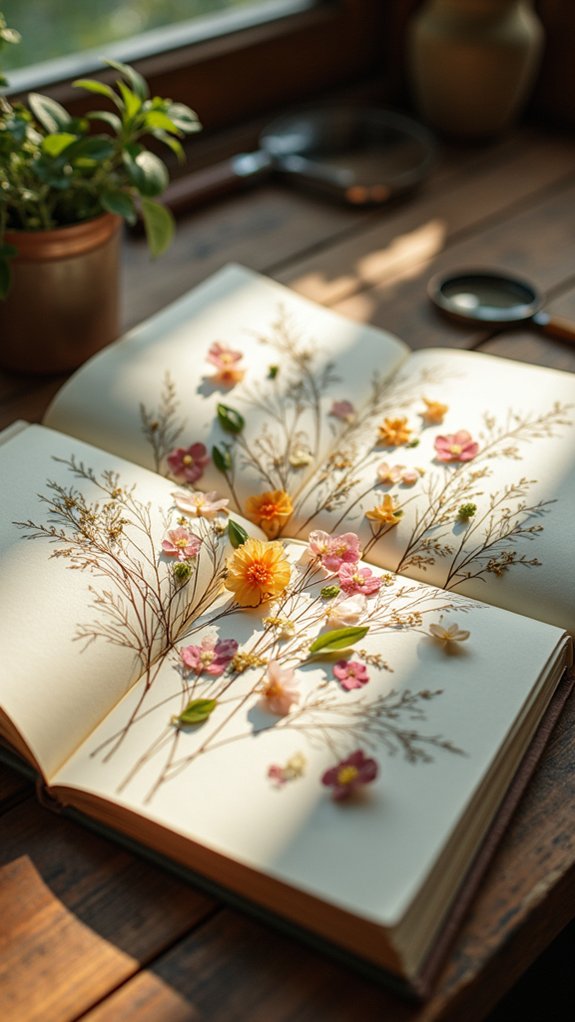
Pressed florals and botanicals bring a bit of wild magic straight into a sketchbook, but picking and pressing flowers isn’t just grabbing the nearest dandelion and squashing it in a book—there are some tricks to getting those colors to pop and those petals to stay flat.
Artists often get inspiration for botanical compositions by looking at how plants and leaves fit together in nature, or even by arranging their own mini bouquets before pressing.
It’s part science, part art, and sometimes part guessing game—because sometimes your favorite flower turns into a crumpled brown mystery no matter how careful you are!
Picking and Pressing Techniques
Nothing says “nature lover” in a sketchbook quite like the look of real flowers and leaves tucked between the pages. Pressing flowers is an old-school craft that’s making a huge comeback, especially when it comes to boosting sketchbook style.
The trick is all about technique—flowers should have around 70% moisture for the best color (nobody wants a crispy brown mess). For impatient artists, microwave pressing or silica gel can speed things up in a flash. Some plants are superstars, like pansies or ferns, because they’re flat and dry fast.
- Choose flat, thin flowers or leaves for snappy results; thick ones take more patience.
- Try a classic book press, or experiment with microwave shortcuts.
- Mix in pressed pieces to add real-life nature vibes and wild texture.
Botanical Composition Inspiration
Wildflowers, ferns, and delicate leaves—there’s just something about adding real plants to a sketchbook that makes it feel like a treasure chest from the outdoors. Pressed florals give sketchbook pages cool texture and bursts of natural color, right from the wild. Artists never know exactly how each flower will look after pressing, and that surprise is half the fun! These botanical bits also help storytellers learn about plant species while getting creative with colors and shapes. Take a look at how pressed florals can boost both mood and skills:
| Reason to Use Pressed Florals | What You Get |
|---|---|
| Texture and color | Pages feel alive and vibrant |
| Nature study | Learn cool science facts |
| Mindful moments | Relax and connect with nature |
| Mixed media fun | Unique, artsy combinations |
Monochrome Magic
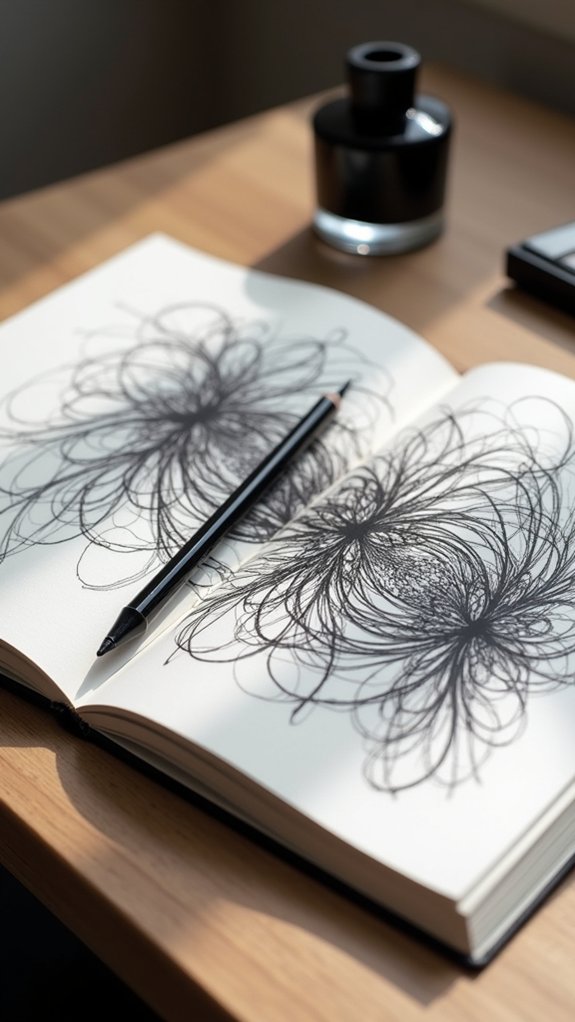
How does a sketchbook become a secret world with just one color? With monochrome magic, artists discover whole galaxies using only shades of blue, a single bold black, or any color they love.
By ditching every other hue, they truly experiment with depth, tone, and texture—no distractions allowed. Even with this simplicity, cashing in on different techniques like hatching or stippling keeps things buzzworthy instead of boring.
Choosing the right color becomes a way to tell a story or set a mood, which gives every monochrome sketchbook a secret emotional boost. Minimalists, especially, can’t get enough of this cool, collected style.
Some favorite ways artists try monochrome magic include:
- Sketching with one color of ink or marker
- Layering watercolor washes
- Using digital tools for striking effects
Mixed Media Blends

After the calm focus of monochrome, it’s like sketchbooks suddenly throw their own little party when mixed media comes into play.
Mixed media blends ask artists to mix and match—watercolors might meet collage, or maybe ink lines zigzag through pastel clouds. It’s wild, unpredictable, and that’s much of the fun.
People can layer patterned paper or even glue in fabric scraps, letting their sketchbooks pop with texture and color. Sometimes, there’s a tiny button or a shiny bit of foil tucked into a corner.
Not only does this add dimension, but it kickstarts creativity, shaking up routines when artists feel stuck. Many say mixed media blends make art more adventurous, breaking up the boredom and reminding everyone that sketchbooks are for experimenting.
Vibrant Color Blocking
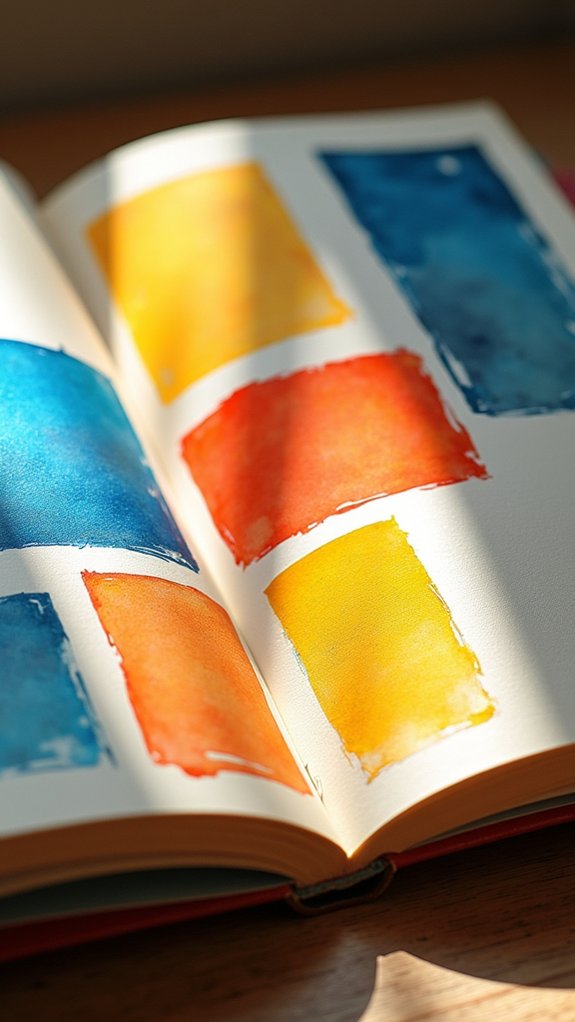
Bright color blocks bring an instant jolt of energy to any sketchbook page, almost like someone turned the lights all the way up and threw open the windows.
Vibrant color blocking is all about using bold, eye-popping colors right next to each other—no tiptoeing allowed! Instead of blending everything together, artists lay down big, solid sections of color in contrasting hues to grab attention and set the mood.
This technique isn’t just for making things look modern or cool (though it definitely does); it helps tell a visual story, too.
- Use markers, colored pencils, or paints to experiment with layering bold colors.
- Try out color theory tricks, like pairing complements for extra pop.
- Highlight certain elements by making them stand out with vibrant color blocking.
It’s creativity released!
Textured Swatch Pages
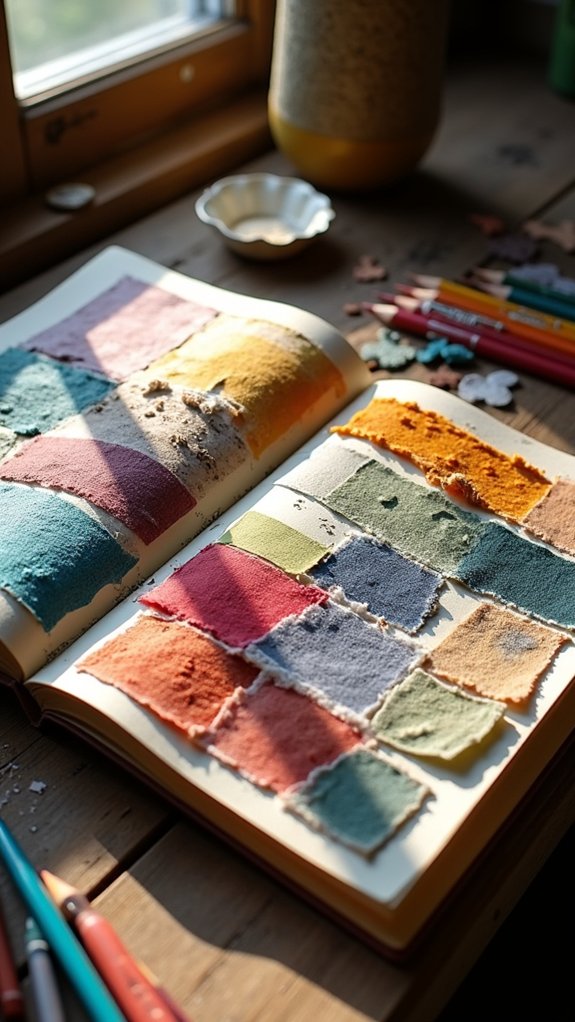
While bold colors might make a page shout, textured swatch pages whisper, “Come closer, check this out.”
There’s something a little bit magical about flipping to a sketchbook page and feeling the urge to touch every square, swatch, and scrap glued down. Textured swatch pages are like having a mini material playground.
Artists can tape in bits of fabric, textured paper, or even a leaf found on the walk to school. Each piece creates a record of how it looks—and feels.
These pages are more than just cool to look at; they help artists remember fun techniques for future masterpieces. Over time, textured swatch pages become a clue to what styles or materials keep popping up.
Who knew personal style could be so touchable?
Whimsical Doodles

Even on those days when sketchbooks feel like blank, intimidating spaces, whimsical doodles have a way of breaking the ice. There’s something magical about doodling with playful shapes, crazy proportions, and pops of color. Whimsical doodles don’t care about rules or being perfect; they’re all about letting your creative side run wild.
These fun little drawings can spark laughter or tell a story, sometimes before you even notice.
- Cartoonish characters with big eyes or wobbly arms just begging for adventures
- Surreal, floating scenes that look like something straight out of a wild dream
- Imaginative creatures with too many legs or rainbow-colored fur
Drawing whimsical doodles is not only entertaining, it’s relaxing, and can even help clear your mind from everyday stress.
Vintage-Inspired Journaling
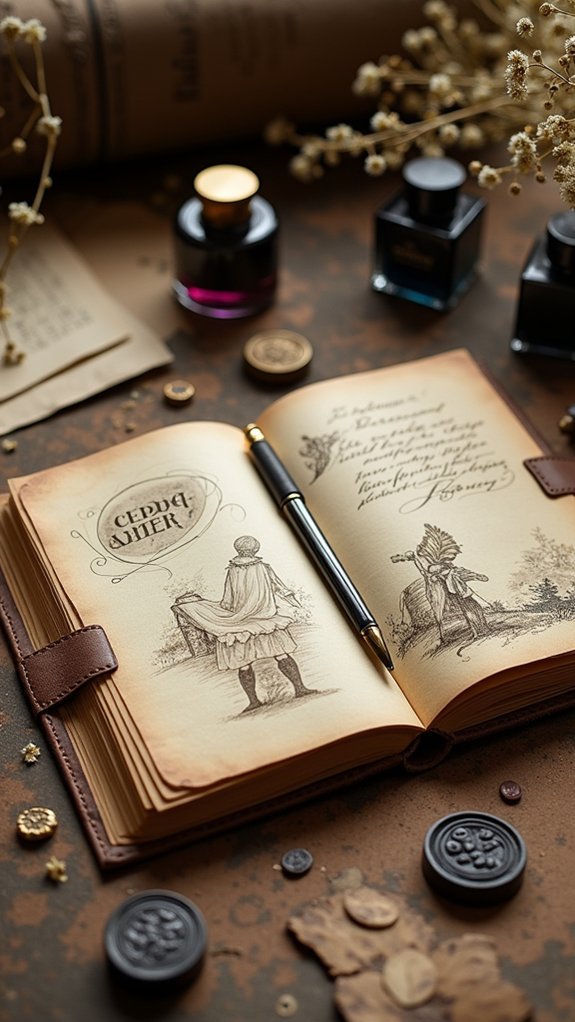
How can a sketchbook suddenly feel like a dusty attic full of forgotten treasures? Vintage-inspired journaling is the answer—a trend that lets artists time travel with nothing but a pen, some washi tape, and a touch of nostalgia.
Old-looking papers, sepia-toned photographs, and antique ephemera make every page look like it belonged to someone’s great-great-grandma. Handwritten calligraphy, lace details, and muted colors work together to recreate the charm of love letters from the past.
Classic literature, vintage illustrations, and botanical prints often become muses. Those who love this style sometimes mix in vintage postage stamps or quirky old drawings, making each page special.
Whether using watercolor, collage, or ink, the result is a warm, story-filled aesthetic bursting with retro vibes.
Interactive Flaps and Pockets
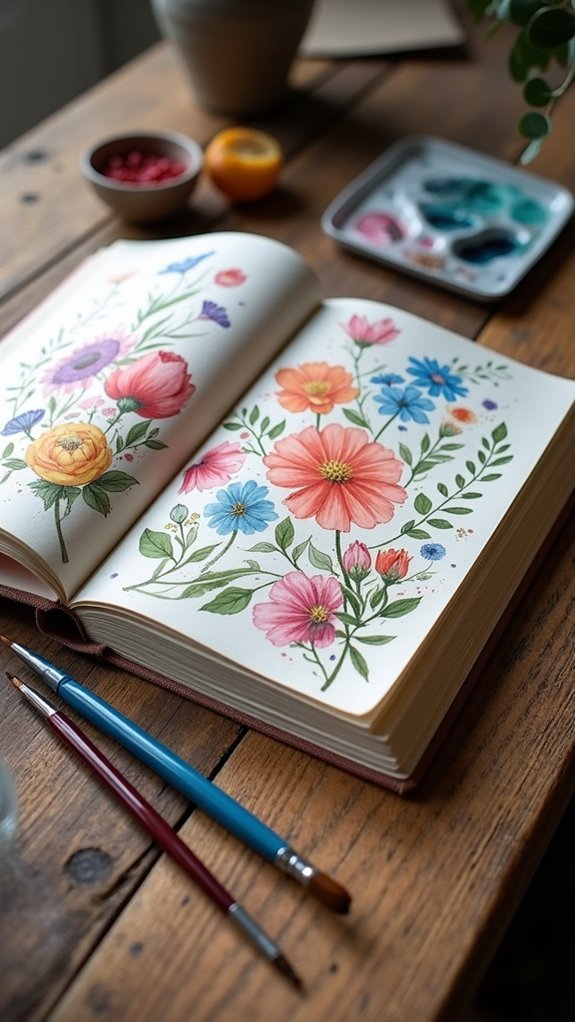
Interactive flaps and pockets are like secret hideouts in your sketchbook, perfect for tucking away memories or little surprises.
Artists can stash notes, photos, or even mixed media experiments behind these clever panels, turning every page into a mini adventure.
It’s a fun way to make art feel personal, playful, and totally unpredictable—kind of like your favorite mystery novel, but with way more glue and glitter.
Secret Spaces for Memories
When flipping through a sketchbook, discovering a hidden flap or secret pocket can feel like finding buried treasure—it’s exciting, mysterious, and a little bit magical.
Secret spaces for memories let artists tuck away everything from silly notes to tiny keepsakes, building an adventure right inside the page. With interactive flaps and pockets, each turn is a surprise, and no one ever really knows what stories might pop up next.
It’s a creative expression that makes a sketchbook personal, playful, and unforgettable. Some fun ways to use these secret spaces include:
- Tucking hidden messages or wish-lists for future self-discovery
- Creating see-through pockets with plastic, so colors and shapes peek out
- Designing flaps that reveal favorite doodles or funny memories
It’s like building your own secret clubhouse—one sketch at a time!
Mix Media Hidden Elements
Peek behind a colorful flap or dig into a pocket made of patterned paper, and suddenly, a sketchbook feels more like a treasure chest than just pages and drawings. With interactive flaps and pockets, every page becomes a playful mystery. Artists hide sketches, secret notes, or ticket stubs, letting viewers uncover surprises like detectives on a mission. Flaps made from fabric or see-through plastic add texture and layers. Pockets hold loose doodles or clippings ready to burst out with inspiration at any moment. Check out how artists use interactive flaps and pockets:
| Element Type | What You Can Hide Inside |
|---|---|
| Patterned Flap | Miniature sketches, secret notes |
| Envelope Pocket | Concert tickets, magazine clippings |
| Transparent Sheet | Hidden layers of art, doodles |
| Fabric Flap | Swatches, tiny souvenirs |
Themed Sketchbook Spreads
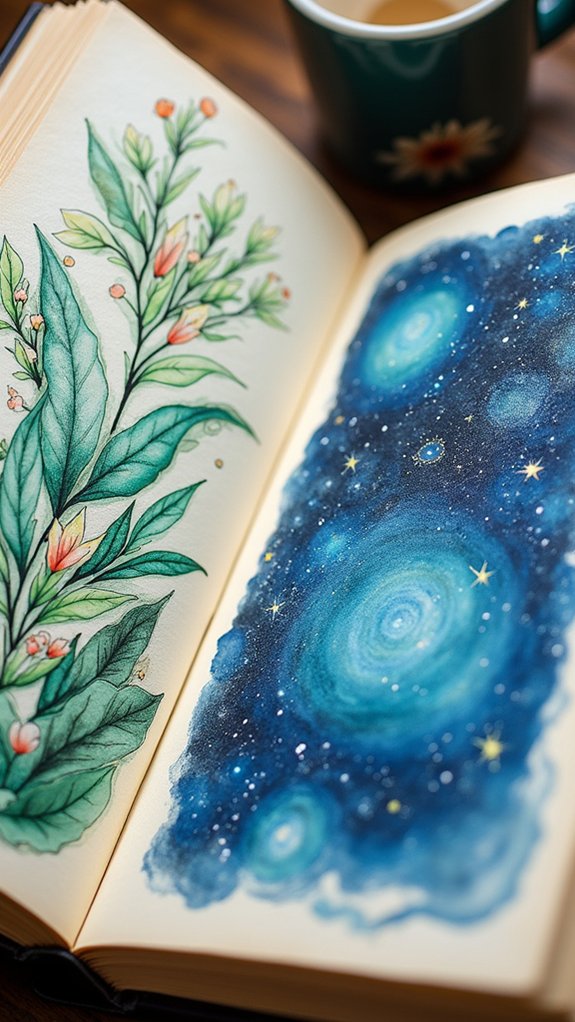
Although a blank page can sometimes feel a little scary, themed sketchbook spreads make things way less overwhelming and a lot more exciting. Giving each spread a unique theme—like emotions, places traveled, or even favorite foods—helps artists focus their imagination and creativity.
It’s kind of like picking your own adventure! Sticking to a color palette ties everything together, so it doesn’t look like a tornado hit your markers and pens. Plus, mixing things up with collage or watercolor adds some awesome texture that jumps off the page.
- Themed sketchbook spreads give artists a creative framework, encouraging deeper exploration.
- Using colors that match your theme keeps your artwork cohesive and visually satisfying.
- Revisiting themed spreads over time helps track growth—like an artistic time machine!
Now that’s some sketchbook magic.
Natural Elements Integration
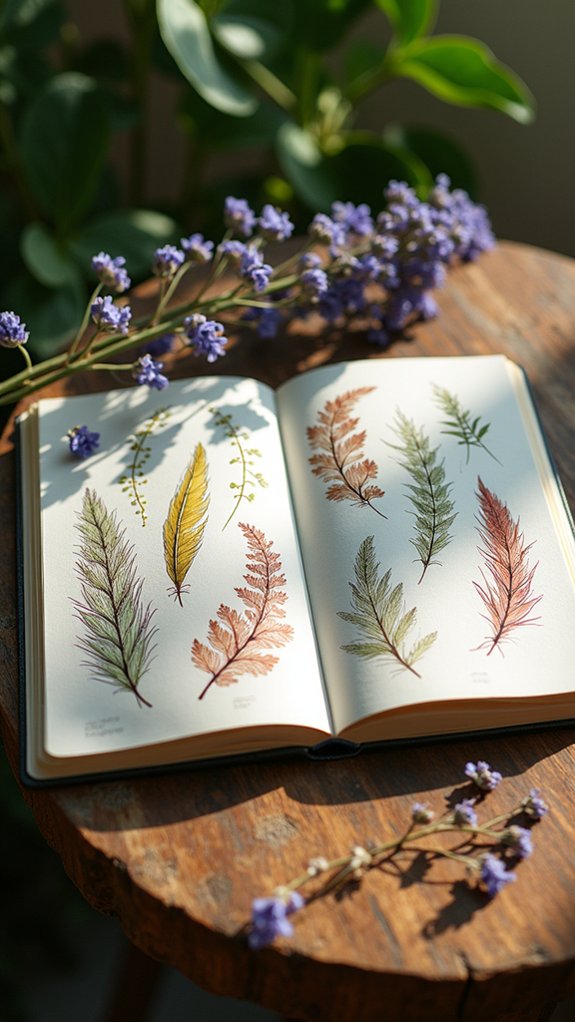
Bringing the outdoors into a sketchbook can make each page feel a little wild and alive, and that’s where botanical illustration techniques really shine.
Artists love to press leaves or layer rough textures from nature, or they’ll grab earth tones and try crazy color combos that look like a forest floor exploded onto the page.
Mixing all these things doesn’t just make sketches look awesome—it’s like capturing the whole vibe of nature with a pencil and some guts.
Botanical Illustration Techniques
Detailed sketches of plants aren’t just for scientists in lab coats—they’re also for anyone who loves drawing, nature, or maybe just a really cool leaf.
Botanical illustration techniques let artists capture every little detail, from the jagged edge of a leaf to the swirl of a petal, in a sketchbook bursting with color and life. Artists usually work right next to real leaves or petals, studying them like detectives at a mystery scene.
Mixing watercolors, colored pencils, and sometimes even ink makes each drawing pop with realism. For anyone dabbling in botanical illustration, a few tricks always come in handy:
- Layering colors to add depth and texture
- Using fine brushes or sharp pencils for tiny details
- Looking at classic illustrators like Merian or Redouté for inspiration
Incorporating Organic Textures
If someone’s ever pressed a crinkly leaf between the pages of a book or smuggled a tiny pine cone into their backpack, they already know how wild and wonderful it feels to bring a bit of the outside world indoors.
Incorporating organic textures into a sketchbook takes that same idea and kicks it up a notch—think leaf veins, bark patterns, or even the bumpy feel of sand stuck to a page.
Artists can use techniques like rubbing leaves under their paper, pressing dried flowers, or layering different materials for a one-of-a-kind look.
Watercolor or ink washes make shapes seem to ripple and spread just like puddles after rain.
Mixing acrylics with natural pigments? That brings artwork to life, full of surprises and genuine, earthy vibes.
Nature-Inspired Color Palettes
Even when walls are covered in posters and the window is open just a crack, sometimes it feels like nature belongs somewhere closer—right inside a sketchbook.
Nature-inspired color palettes are all about capturing that outdoor magic, using earthy greens, deep browns, and fresh blues, just like forests, mountains, or the ocean. Mixing in natural elements like flowers, leaves, or even rocks (but probably not inside your backpack!) brings sketches to life in a seriously cool way.
Artists use these calming colors and themes for an art vibe that feels grounded and peaceful.
Try these ideas:
- Stick to a limited nature-inspired color palette for smooth, unified pages.
- Sketch real plants or stones to match your mood and colors.
- Layer on textures—bark, sand, water—to strengthen the natural theme.
Pattern Play and Repetition
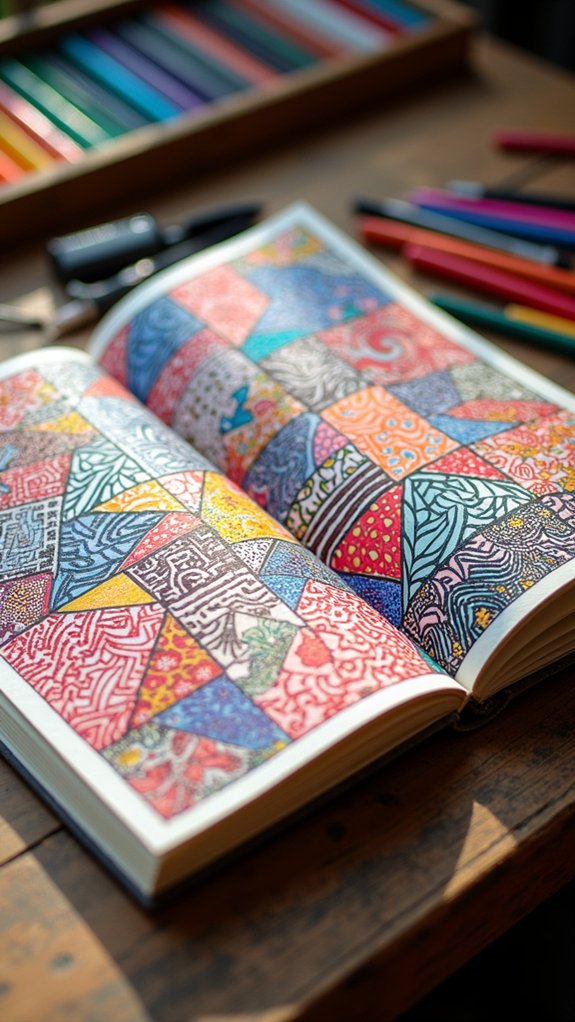
Dive right into the world of pattern play and repetition, where sketchbooks suddenly feel like playgrounds for shapes, lines, and all kinds of fun doodles.
Pattern play is basically a party for your page—think of repeating zigzags, swirls, or polka dots making everything pop with personality. Artists use repetition to build muscle memory, so drawing clean circles or sharp triangles gets easier each time.
Some doodle wild geometric grids, others like to chase after wobbly organic patterns—anything goes! Mixing up colors, overlapping lines, and layering different textures can turn a simple page into a complex masterpiece.
Plus, there’s something oddly calming about filling a page with repeated shapes. It’s like a brain massage, but with more ink and less questionably scented candles.
Illustrated Daily Logs

After scribbling page after page of patterns and shapes, some artists want their sketchbooks to record actual life, not just wild imagination. That’s where illustrated daily logs come in—they’re like a diary and an art project rolled together.
Artists combine doodles, notes, and bursts of color to capture their days. It’s a routine that turns ordinary moments into creative gold, and honestly, it’s way more fun than just plain writing. Plus, neuroscientists say sketching helps you remember things better, so that doodle of yesterday’s weird lunch might actually stick!
- Mixing watercolors, ink, and collage brings layers of meaning—and more “wow” factor—to even the simplest entry.
- Themes or prompts can zap away “blank page panic” and kick off new ideas fast.
- Color coding and sketches turn each log into a memory-packed adventure.
Sticker and Washi Tape Accents
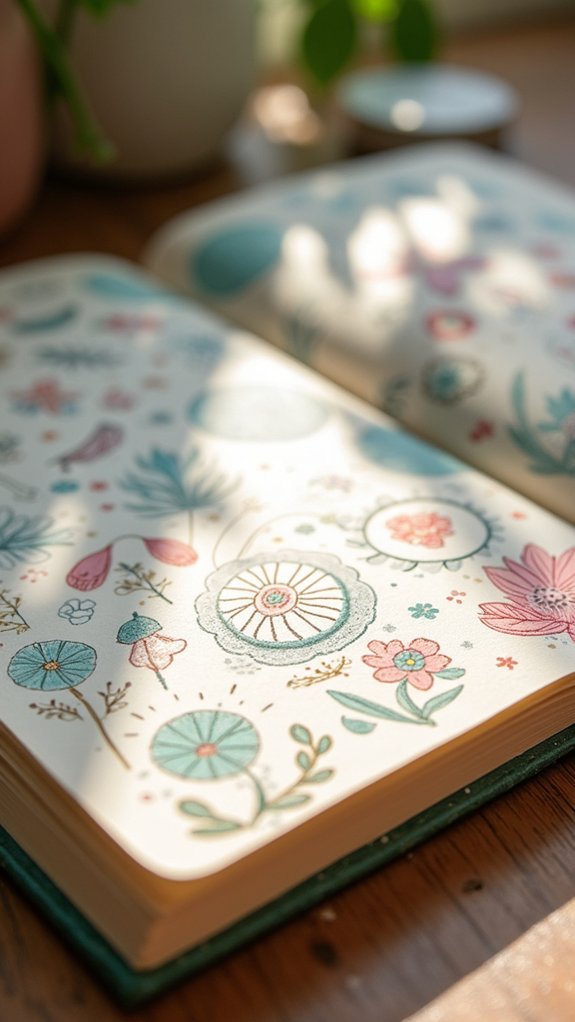
Adding stickers and washi tape to sketchbook pages is like giving your art an instant personality boost and a pop of fun—suddenly, those empty corners become your playground.
By layering stickers with washi, artists build mixed media effects that jump right off the page, turning each spread into a unique story only they could tell.
It’s not just about decoration—it’s about putting your own twist on every page and letting your sketchbook shout, “Hey, this is totally me!”
Layered Mixed Media Effects
Every sketchbook has the potential to burst with personality, and layered mixed media effects are a go-to way to make that happen.
By mixing and matching art supplies—like playful stickers and colorful washi tape—artists can turn a blank page into something way more interesting.
Layering these materials doesn’t just make the art pop, it also lets anyone experiment without being a pro at drawing.
Want a border that looks fancy? Add washi tape.
Need some quick fun on a page? Put on a sticker!
It’s almost like building your own mini world, one sticker or tape piece at a time.
Here are some creative ways artists use layered mixed media effects in their sketchbooks:
- Create eye-catching frames
- Add vibrant pops of color
- Build dynamic, touchable textures
Personalizing Visual Narratives
Ever wondered how a sketchbook can start to feel like a story that’s completely your own? That’s where stickers and washi tape come in.
With their wild variety of patterns and colors, washi tapes aren’t just fancy tape—they’re instant page dividers, funky frames, or eye-catching borders that give your sketches a big boost.
Stickers? They’re the secret weapon for adding fun prompts, sparking ideas, or highlighting favorite parts of a page.
Every sticker or piece of tape chosen is like a clue to your personality, making each spread unique. Plus, decorating with them feels like playtime, not work.
Suddenly, the blank page isn’t so scary—just more space for colors, stories, and a few ridiculous pizza slice stickers.
Continuous Line Drawings
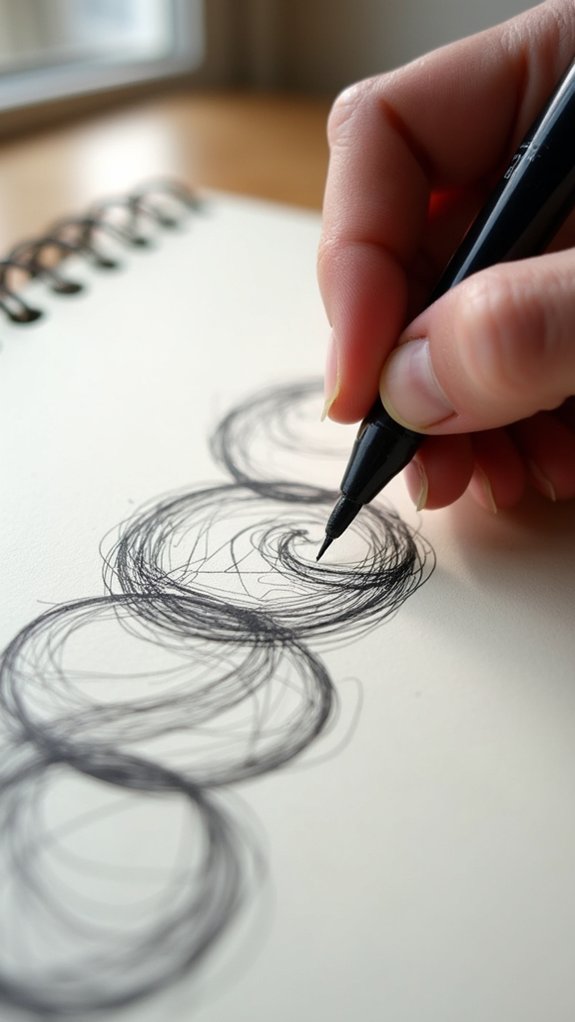
Continuous line drawings might look simple, but there’s something kind of magical about making a whole picture with one never-ending line. This sketchbook style isn’t just about looking cool—it’s also a bit of a brain workout.
When artists try continuous line drawings, they have to focus hard and really observe their subject, since they can’t lift their pen or pencil off the paper. The results are often abstract, fresh, and packed with personality. Plus, it’s a great way to loosen up before tackling more complicated sketches.
Some key things that make continuous line drawings a must-try are:
- They boost hand-eye coordination like a secret art ninja move
- Minimalist, bold, and instantly eye-catching
- Artists can experiment with pressure changes for fun effects
Talk about stylish simplicity!
Dreamy Watercolor Effects
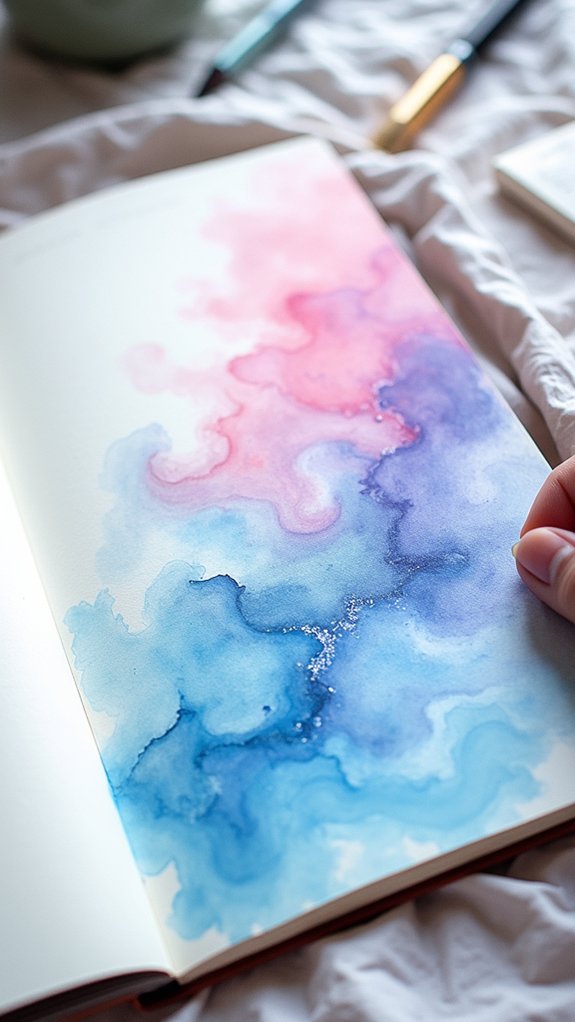
After those bold and punchy continuous line drawings, watercolor sweeps in like a gust of invigorating, misty air.
Dreamy watercolor effects are all about soft, blended gradients that make a sketchbook page look like it just woke up from an amazing nap. Using watercolor techniques like wet-on-wet, colors flow and merge, creating a peaceful vibe.
Layering washes lets artists build an ethereal quality—so magical, it almost feels unreal—without hiding the sketch below. Throw some salt or plastic wrap on wet paint, and wild textures appear by surprise (it’s like art magic).
Soft outlines keep everything gentle, never harsh. And a limited color palette—think pastel-only zone—makes these pages look calm and harmonious.
The dreamy look? Seriously fun and beautifully laid-back.
Personal Storytelling Pages
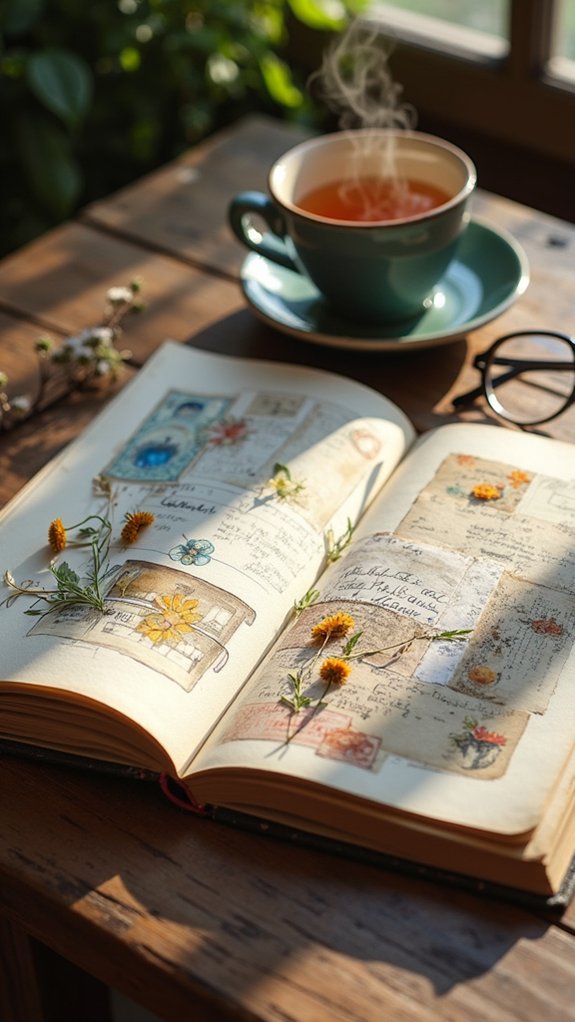
Sometimes, sketchbook pages turn into way more than just a place for doodles—they become basically a personal diary, but with extra art supplies and fewer cringe middle school secrets. That’s where personal storytelling pages come in.
These pages let artists mix pictures, words, and anything they can glue down to share stories from their own lives. It’s about turning those weird life moments, funny memories, and real emotions into something you can actually see and touch.
Personal storytelling pages aren’t just cool to look at—they help artists understand themselves better, too.
- Mix it up with drawings, photos, and collage to make stories pop
- Use prompts or timelines for organizing wild thoughts
- Jot down small memories for extra feels and personal flair
Frequently Asked Questions
How Do You Make an Aesthetic Sketchbook?
Creating an aesthetic sketchbook involves selecting quality art supplies, curating a consistent color palette, and layering mixed media elements. Thoughtful page layouts, hand-lettered details, and a blend of finished art with spontaneous sketches enhance visual interest and creativity.
What to Draw 100 Ideas?
When considering what to draw, individuals often seek a diverse list of Creative Prompts. Popular suggestions include everyday objects, imaginative scenes, unique perspectives, mixed media explorations, themed days, and studies of texture, material, and narrative elements.
How to Spice up a Sketchbook Page?
To enhance a sketchbook page, one can explore diverse page layout techniques, integrate mixed media elements, experiment with color choices, and add personalized touches such as handwritten quotes, ultimately creating visually appealing and engaging composition within each spread.
What’s the Coolest Thing to Draw?
When considering the coolest thing to draw, many gravitate toward fantasy terrains. These scenes blend surreal elements and imaginative environments, allowing artists to explore creativity freely while crafting intricate worlds filled with whimsy, mystery, and visual intrigue.
Conclusion
So, sketchbooks don’t have to be boring, right? With these 19 trends, anyone can mix things up, experiment, and totally surprise themselves—maybe even shock their cat with a wild collage or a moody watercolor. Each page becomes a chance to try something new or to show off a style no one else can copy. Seriously, whatever someone’s vibe is, their sketchbook can capture it. Go grab those markers and get weird—art rules are meant to be broken!

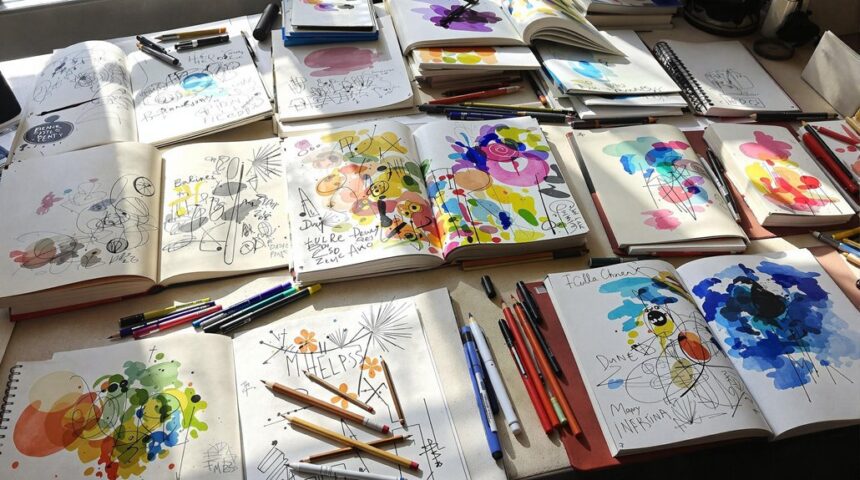
Leave a Reply